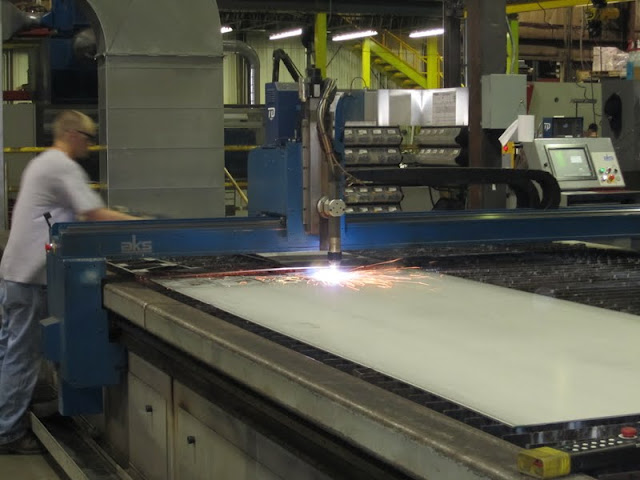This is our newest addition to our tanker fleet. Keep reading to see how this piece of equipment was built and what it will haul.....
I had the opportunity this week to travel to the Polar Trailer manufacturing plant in Holdingsford, MN. I was able to tour the factory and inspect our new Super Tanker. Polar is well known in the country for building the highest quality tankers available. Fits well for us to use, being the highest quality fertilizer manufacturer in the country.Below they are forming a head manually with a press. This is done for very thick and large heads.
Most heads are hydroformed. You can see an example on the right of the photo. They are cutting one down to size. This is done after the barrel is formed to get an exact fit. They cut it and then roll the edge to prepare for welding to the barrel.
Here they are computer cutting. This is done for an exact cut and the computer generates extra parts out of the sheet to minimize scrap.
This is the largest metal shear in the midwest. They use it to cut the edges of the sheets they purchase so that they are perfectly straight for welding. There are many things that make Polar trailers the best and the quality of the welding is one.
Below is another computer guided cutter. They have plasma and laser cutters, some cooled with water. They have these machines well enough tuned to cut bolt holes as small as 3/8 in.
On this shear they cut the barrel sections before they are rolled. A single compartment barrel would have several pieces.
This is the welding machine. The sheets are butted togetherand welded very precicely.
Below is the machine that is used to Burnish the welds. It is basically a press wheel that preflatens them before finishing.
Here are the grinding/polishing wheels. This us what makes the Polar trailers look so nice.
You can see how great the welds look when they come out of the machine.

Below they are beginning to roll the barrel. They can roll up to 1/2 in SS on this roller.
The picture here is of the guy in the back, not the guys in the front. He is butt welding the final barrel weld in the same machine we looked at before.
Here is the barrel assembly area. They weld on the heads, rings, manways, and any other outlets here.
All of the tanks are on rollers and the welders can roll them around to work on them.
This is a picture of a heat panel on a tanker. Hot fluid is pumped through this to keep a load hot.
Each of the dimples must be fully welded. They have a machine that does each hole with the pull of a trigger. They then weld a "manifold" on each end to pump to or from.
Below is someone hand polishing part of a bumper. There is a lot of this going on throughout the plant.
Here they are assembling piping assemblies. Polar has a new pipe bender that eliminates most of the welded joints in our piping. This makes for much less potential for leaks.
Here they are manufacturing 5th wheel plates. Polar provides a huge amount of aftermarket parts for all manufacturers. We can call with a serial number and they will make any part that we need.
Here they are making light boxes. These are newly redesigned so that the parts are more interchangable.
Here they are assembling axles. This is one of the few things that is not manufactured right on site. To the list, we would only add wheels and tires, electrical components and pumps.
Here is a picture of an insulated jacketed trailer before the end cap is placed.
Here was my first look at our new trailer. I was able to go over the trailer and they made a few minor alterations to make this work better.
It is a fantastic looking trailer. One of the few double conical (center drain) trailers of this size. It has a flowmax 15 pump and a big motor so that it will unload in 30 minutes.
We tested all of the axle components outside. The trailer is configured to run in Michigan and Canada. The electronics are impressive. The front two axles are steerable, the four rear are fixed. When you back up the steerable lift axles automatically lift and go back down after 9 revolutions forward. It also has a scale on it to tell us how much weight is in it.
The trailer will be used for deliveries in Michigan and Canada. It can haul 9000 gal of Sure-K, 9000 gal of Micro 500, 7500 gal Pro-Germinator, 7950 High NRG-N or 84,600 lbs. That is if we all did our math right. This was a very complicated engineering job for Polar with several weeks of engineering time from thier top engineers.
The trailer fits well the theme of the new plant - Big, Fast, and well designed. It will have quite a bit of setup and calibration to get done and needs some LIQUID logos. Maybe I can get a picture later when it looks completely finished.


























No comments:
Post a Comment